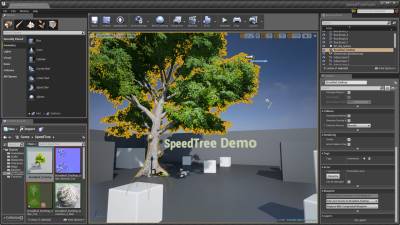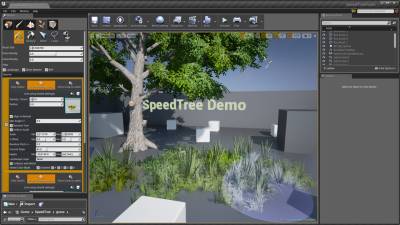meta data for this page
This is an old revision of the document!
Importing into UnrealEngine4 (ST9 Format)
SpeedTrees are supported in the UnrealEngine4 (UE4) game engine. The .ST9 files exported by SpeedTree 9 can be imported with Unreal Engine 4.27 or later.
Differences from ST
Pipeline to UE4
Before exporting a tree for UE4, be sure that your tree is set up for real-time use by using LOD. Also ensure that wind is correctly set for UE4 by setting the fan to Games mode and tuning the wind effects, if necessary.
If this is the first time exporting to UE4, be sure to pick one of the UE4 presets in the export mesh dialog, to ensure all the export settings are correct for UE4. Export an .ST file to disk, then switch to UnrealEd and import the ST file there. The mesh and all textures should be found and imported into your UE4 project assets.
On import, material instances will be created for all of the materials in the ST9 file.
Placement
 Once you've imported the model as an asset you can place it in your scenes like you would any other static mesh. Simply drag the asset and drop it in the scene to place a model. Mark them as “static” to use them with Lightmass (you'll need a good lightmap uv) or “moveable” to have them be dynamically lit and shadowed.
Once you've imported the model as an asset you can place it in your scenes like you would any other static mesh. Simply drag the asset and drop it in the scene to place a model. Mark them as “static” to use them with Lightmass (you'll need a good lightmap uv) or “moveable” to have them be dynamically lit and shadowed.
 You can also paint the tree with a foliage layer. Drag the asset into foliage painting area and paint the SpeedTrees like any other static mesh. See UE4's foliage tool documentation for more information.
You can also paint the tree with a foliage layer. Drag the asset into foliage painting area and paint the SpeedTrees like any other static mesh. See UE4's foliage tool documentation for more information.
Wind
Wind behavior can be tuned inside of the SpeedTree Modeler or in the material instances.
The wind strength used in UE4 is the same.
LOD
Your LOD behavior is set in the SpeedTree Modeler, but you can adjust when the LOD changes occur inside of UE4. LOD transitions are based on screen space area, and these values can be edited in the static mesh editor associated with the SpeedTree model. Default values are chosen upon import that work for typical situations.
Materials
The SpeedTree materials created by the importer get the basics in place but can be edited to improve and tailor them to suit your scenes.
The SpeedTree node connected to WorldPositionOffest is the only SpeedTree-specific component in the material. If you disconnect it, everything rendered with that material will be identical to a static mesh. With it connected you will get SpeedTree wind, camera-facing geometry, and smooth LOD transitions.
There are several options available on the SpeedTree node.
Billboard materials contain a few extra material functions that remove non-camera-facing polygons from the billboard mesh and adjust the normals to avoid seams in the billboard mesh. These can be opened up for editing, as well.